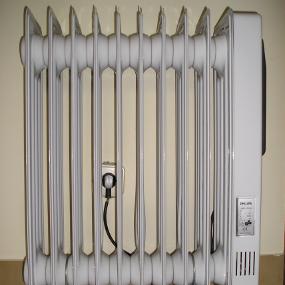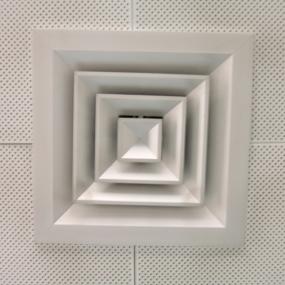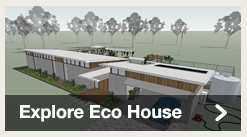Build it Back Greenbushfires
Heaters
 Building a new home is a
great opportunity to be able to design your home so as that you can
limit the amount of energy you need to use on heating. By following
solar passive design principles, making sure your house is well
insulated and draught-free, fitting good glazing or protected
windows, you can make your home more energy efficient and can
reduce the amount of active heating that is needed.
Building a new home is a
great opportunity to be able to design your home so as that you can
limit the amount of energy you need to use on heating. By following
solar passive design principles, making sure your house is well
insulated and draught-free, fitting good glazing or protected
windows, you can make your home more energy efficient and can
reduce the amount of active heating that is needed.
The ideal surrounding air temperature for the human body is around 23°C.
However, this is for a body at rest, with light clothing, so there is no reason to run a heating system at this temperature. Generally a home will be comfortable with the thermostat set to around 20°C or even a bit lower, depending on what you are doing and what you are wearing. For every degree above 20°C that you set the thermostat, you use around 15% more energy to maintain that temperature.
Reverse cycle air conditioners
Reverse cycle air conditioners work not by using electricity to make heat directly, but by using it to move heat from one place to another. In a reverse-cycle air conditioner, heat is taken out of the cold air outside and dumping it inside where it is needed. Because the electricity is only being used to run the fan and compressor motors, it is not unrealistic for an air conditioner using 2000 watts (2kW) to generate the equivalent of 6kW of heat.
This gives them an effective efficiency of well over 100%-in this example, the efficiency, or more accurately, the coefficient of performance (COP), is 300%, or a COP of 3. This makes the reverse-cycle air conditioner a better option than an electric radiant or fan heater-you get far more heating capacity for the energy dollars spent.
However, the initial purchase price is much higher-up to $1000 or more, depending on the size of the machine-but this may well be recovered by much lower energy bills in just a few years.
Radiant heaters
Electric radiant heaters are cheap to buy but expensive to run, and may be suitable for short-term uses such as in bathrooms-where you only want to heat you, not the whole room-as they are quick to heat up. Another version of these are the heat lamps found in many bathrooms. These are basically a large incandescent (which means glowing) element inside a glass bulb, and are designed to produce heat more so than light, although they do produce both. These bulbs are usually rated between 250 and 500 watts, making them similar in energy use to small radiant bar heaters. However, if they are used as lights and not just heaters, they can end up using a lot more energy than they should.
Gas heaters
Gas heaters use a gas flame to heat ceramic plates to orange heat, which then radiate heat into the room. They usually have a circulating fan that causes hot air to exit from the grill at the top of the heater, and indeed many units, usually known as wall furnaces, produce all of their heating in this manner.
They are ideal for heating large individual rooms or pairs of adjoining rooms, but can't heat an entire home unless it is relatively small and open plan. They are best suited to homes with relatively low ceilings. They also need to have a flue exit through the roof or wall of the home, which can detract from the look of the installation in some cases. Efficiency of this type of heater is quite good.
Some gas heaters are unflued, but these require good ventilation and so are less efficient, as outside air must continually enter the room to keep combustion gases to safe levels. They are not recommended.
Gas fake flame heaters (gas log fires)
If you love the look and feel of real flames, then a gas log fire is a possible option. They are far cleaner than an open fireplace, in both terms of maintenance and pollution produced, and many of them are quite convincing and look great. Efficiencies of these heaters vary somewhat, so you must ask about their heating ability compared to fuel consumption when buying.
Gas log fires have similar attributes to wall furnaces and similar gas heaters, and indeed are often considered to be in the same class as far as heating systems are concerned.
Gas central heating 
The most common form seems to be gas ducted central heating, which has a large gas furnace outside or in the ceiling which pumps heated air to ducts in the ceiling or floor of each room. A system that can heat a whole home will use a lot of gas, so you must expect gas bills to jump up to several hundred dollars a quarter during the winter months. Obviously, this cost also corresponds to a similarly high production of greenhouse gas, although emissions from gas heating systems are usually much cleaner than electric heating systems.
One thing to watch out for with central heating systems is the placement of the thermostat controller. If it is placed away from the living areas and where there are no heating ducts, it will rarely give an accurate indication of the temperature in those living spaces, and may have to be set much lower than the temperature required.
Maintenance for these systems can be higher, and for roof-mounted systems, much more difficult. Installation can also be more expensive, especially for roof mounted systems, as part of the roof usually has to be lifted to install the heater as they are too large to fit through the average ceiling manhole.
Ducted systems also need (or should have) regular duct cleaning to remove any build-up of dust. This should be done for performance and hygiene purposes, as well as to reduce any possible fire risks.
Another advantage of ground-mounted systems compared to roof mounted is that floor mounted heating outlets can usually be closed, so you don't have to heat the entire home, but rather, just the area in use. There will usually be a minimum number of vents that must remain open.
Gas hydronic heating
Hydronic systems use heated water to heat the home by piping it through radiators in the major living areas of the house or pipes placed in the concrete slab of a home. The radiators heat objects nearby directly, as well as by heating the air in the home. These systems can be quite efficient and have the advantage that the radiator temperature can never exceed the boiling point of water, so can never be a fire hazard. This makes them ideal for drying clothes, or for homes with children.
Hydronic systems are usually gas fired, but can also source their heat from heat pump water heaters or even wood fired boilers.
Hydronic systems are best installed at the time of house construction so that the plumbing can be placed either in the concrete slab or through the walls.
There is also option for solar hydronic heating.
Solar flat plate and box collectors
These consist of a large area glass-covered flat box that is used to heat air which is then pumped into the home using a fan. Small (1 x 2 metres) flat box heaters can be used to heat rooms individually, while larger (3 x 4 metres) roof-mounted collectors can heat an entire home, at least when the sun is shining. These types of solar heaters have the advantage that they can be added to any home that has good solar access-meaning it has some roof space or window space facing north without being overshadowed by trees or other obstructions.
Suppliers
Ecosmart Fire - www.ecosmartfire.com
Greenheat - www.greenheat.com.au
HRV - www.hrv.com.au
Ph. 1800 478 123
Jet Master - www.jetmaster.com.au
Ph. 1300 538 627
Real Flame - www.realflame.com.au
Smartbreeze - www.smartroof.com.au
Ph. 03 9510 3484
Solar Venti - www.ges.com.au
Sun Lizard - www.sunlizard.com.au
- More Info
- > ResourceSmart - Heating
- > Your Home
Listed suppliers are a guide and are not endorsed by Green Cross Australia or the Alternative Technology Association.




